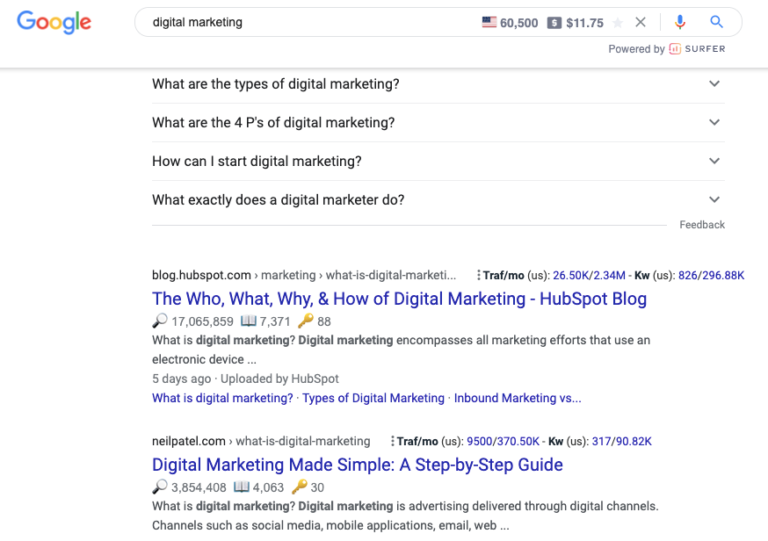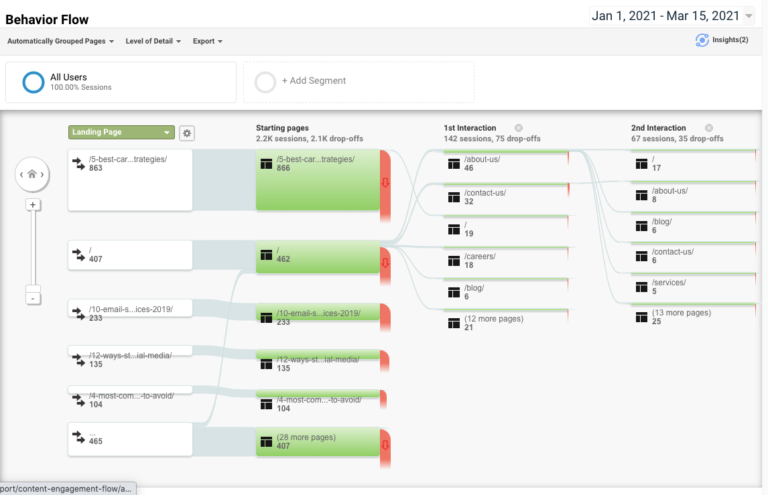More isn’t always better.
When it comes to content, marketers and business owners alike are guilty of focusing on longer, keyword-heavy content. The result is often a gap between high-volume content creation and high-quality content consumption.
Want to create content your audience is itching to gobble up? Personalization is the way to go.
Here are six ways today’s top sites are personalizing their on-site content for more views, engagement, and conversions.
1. Dig Into Search Intent
Writing for search intent is not a new concept, but it is highly misunderstood. Search intent is not only about what keywords are used, but what users intend to find when they conduct their search.
Therefore, your on-site content should not only utilize the keywords you intend to target but provide information that speaks to what the user is actually searching for, as well.
For example, at face value, the keyword “digital marketing” may imply that the user is looking for digital marketing services.
But with some critical thinking – and a quick search of this term in Google – you’re likely to find articles that talk more about what digital marketing is and how it works.

Before you write your content, think about what your target users may be searching for when they Google that term.
Then, write content that thoroughly covers that topic from the perspective of that specific search intent.
This is an example of personalization at a broader scale, as you are going beyond writing for Google (i.e., keyword targeting) and instead, writing content for the real people who are searching for content like yours.
2. Create Customer Profiles
When we ask clients, “Who is your target audience?” we often get generic answers like “small business owners” or “coaches and consultants.”
But these answers tell us very little about what these people are searching for, what they’re struggling with, and what their goals are.
That’s why it’s important that you conduct market research to dig into your target audience’s psyche, so you can create accurate customer profiles. This information is used to personalize your content to the exact customer you are trying to reach.
One way to conduct market research is to use Google Forms to send anonymous surveys to people in your target audience. You can do this via outreach on social media or push it out to your email list.
Questions to ask include:
- What are you struggling with the most (in your business/life) at this moment?
- What solutions have you tried in order to overcome this struggle?
- What questions do you have about (topic)?
- What are your main complaints about the solutions you have tried in the past?
- What is your #1 goal when it comes to (topic/product/service)?
Sourcing answers to just these few questions will help you write content that speaks to the unique interests and concerns of your target audience.
As you go on, you can add to these customer profiles so you can come up with better content ideas, sales copy, ad copy, and more.
3. Track and Analyze User Behavior
One of the best ways to create personalized content suited to your audience’s interests is to track their behavior on your website.
Seeing which content they engage with most can give you a good idea of what type of content to create next.

Above is an example of a Google Analytics Behavior Flow report that shows the site’s top landing pages (within a given period) and which pages users move to next.
This has somewhat to do with the internal links you include in your content, but can also be a reflection of the topics that most interest your audiences.
There are other types of reports in Google Analytics that provide valuable information about how users engage with your content.
Use this insight to inform your on-site content strategy and fine-tune your content funnel for more conversions.
4. Utilize AI-Driven Product Recommendations
Artificial Intelligence (AI) technology is helping business owners and marketers provide better and highly personalized content to users.
One way to use AI to personalize your on-site content is to utilize tailored product recommendations.
This is a way to offer the best product suggestions based on what shoppers are most likely to buy.
AI tools use existing user data to display certain products to users based on what they have viewed or purchased in the past. Try displaying “like items” that are related to the user’s initial search or what they’ve added to their shopping cart.
There are a variety of ways to use AI to optimize your ecommerce website and improve personalization.
5. Enable Dynamic Search
Do you have a search bar on your website? If so, you can enable dynamic search to direct users to the content they’re most likely to be interested in.
Without dynamic search, a user may search for a certain topic just to find that you haven’t covered that exact topic on your website.
But with a dynamic site, you can make content suggestions that keep users on your site and encourages them to engage.
For example, if a user searches for “digital marketing tips” but you don’t have an article covering this topic, you could instead direct them to an article covering “SEO tips,” “What is digital marketing?” and the like.
Your goal is to help users find what they are looking for as quickly as possible, and to keep them on your site until they convert into a subscriber or customer.
6. Go Beyond “Pain Points”
You’ve probably heard the advice to “Write with your audience’s pain points in mind.” When it comes to applying market research to your content, this is certainly true.
But you should also go beyond pain points to create content that generates real demand.
In many cases, your audience may not know they even have pain points. They certainly aren’t ready to fork over money for you to help you solve them.
So, where do you start if your audience isn’t even problem-aware?
In this case, you can create informative content that covers the main questions your audience has, then funnel them from there to content that helps them discover they do, in fact, have struggles.
Logically, you can help with solving those struggles.
For example, a common search term is “how to grow my business.” In this case, the user may not know that what they’re missing is SEO or digital marketing in general.
A smart content funnel may look something like this:
- Article: “6 Ways to Grow Your Business from Zero.”
- Article (linked): “10 Digital Marketing Strategies for New Businesses.”
- Article (linked): “What is SEO and Why You Need it to Grow.”
- Page (linked): “Start Here: SEO for Growing Businesses.”
- Page (linked): SEO Services page.
- Page (linked): Contact Us + call-to-action.
In the above example, you take users from their initial query (“grow my business”) to realizing they need digital marketing services to finally deciding that they should hire you for SEO.
Don’t get ahead of yourself by going straight to the hard-sell.
Nurture your audience with personalized content that speaks to their needs and then use tools (like Google Analytics and AI) to further optimize your on-site content.
More Resources:
- Content Experiences Are the New Content Marketing
- Top 20 Tools That Will Help You Create Better Content
- Content Marketing: The Ultimate Beginner’s Guide
Image Credits
All screenshots taken by author, March 2021





